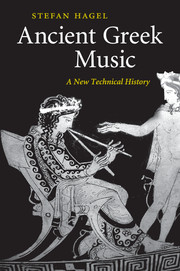Book contents
- Frontmatter
- Contents
- List of diagrams
- List of tables
- List of figures
- List of abbreviations
- Preface
- 1 The evolution of ancient Greek musical notation
- 2 Notation, instruments and the voice
- 3 Notation in the handbooks
- 4 Strings and notes
- 5 Fine tuning
- 6 Going beyond Ptolemy?
- 7 Assisted resonance
- 8 The extant musical documents
- 9 Aulos types and pitches
- 10 Before Aristoxenus
- 11 Synthesis
- Bibliography
- Indices
10 - Before Aristoxenus
Published online by Cambridge University Press: 03 May 2010
- Frontmatter
- Contents
- List of diagrams
- List of tables
- List of figures
- List of abbreviations
- Preface
- 1 The evolution of ancient Greek musical notation
- 2 Notation, instruments and the voice
- 3 Notation in the handbooks
- 4 Strings and notes
- 5 Fine tuning
- 6 Going beyond Ptolemy?
- 7 Assisted resonance
- 8 The extant musical documents
- 9 Aulos types and pitches
- 10 Before Aristoxenus
- 11 Synthesis
- Bibliography
- Indices
Summary
EARLY NOTATION
At the beginning of our investigation we have surveyed the evolution of tónoi from a perspective as abstract as possible, starting from the notation system. Now that we have understood much about the material background of ancient music it is time to reconsider our first conclusions, qualifying and perhaps correcting them where appropriate.
The signs
Firstly, our examination of the notation was almost exclusively concerned with enharmonic scales, in accordance with what Aristoxenus reports about his predecessors. In instrumental practice, however, the diatonic was older than the enharmonic. In aulos music, at any rate, the enharmonic could not possibly replace the diatonic entirely. The uneven arrangement of enharmonic notes with its ditone gaps does not correspond to a useful series of finger holes. If a tetrachord is played on four holes, these will include the diátonos, while the pyknón can be divided only by means of half–stopping holes (or, perhaps, adjusting the embouchure). If it was played on three holes, as is conceivable in the higher range, the disposition of the hand suggests omitting rather the lower hole, while the diatonic hole stays in place.
In consequence, whenever the notation served for aulos music, the diatonic notes must have formed part of it. In the simple ‘Lydian’ core scale, this concerns two notes. The upper is supplied by, the alternative nḗtē of the synēmménon tetrachord, and, according to the ancient view, one of the two possible nêtai of traditional lyre tuning.
- Type
- Chapter
- Information
- Ancient Greek MusicA New Technical History, pp. 366 - 441Publisher: Cambridge University PressPrint publication year: 2009



